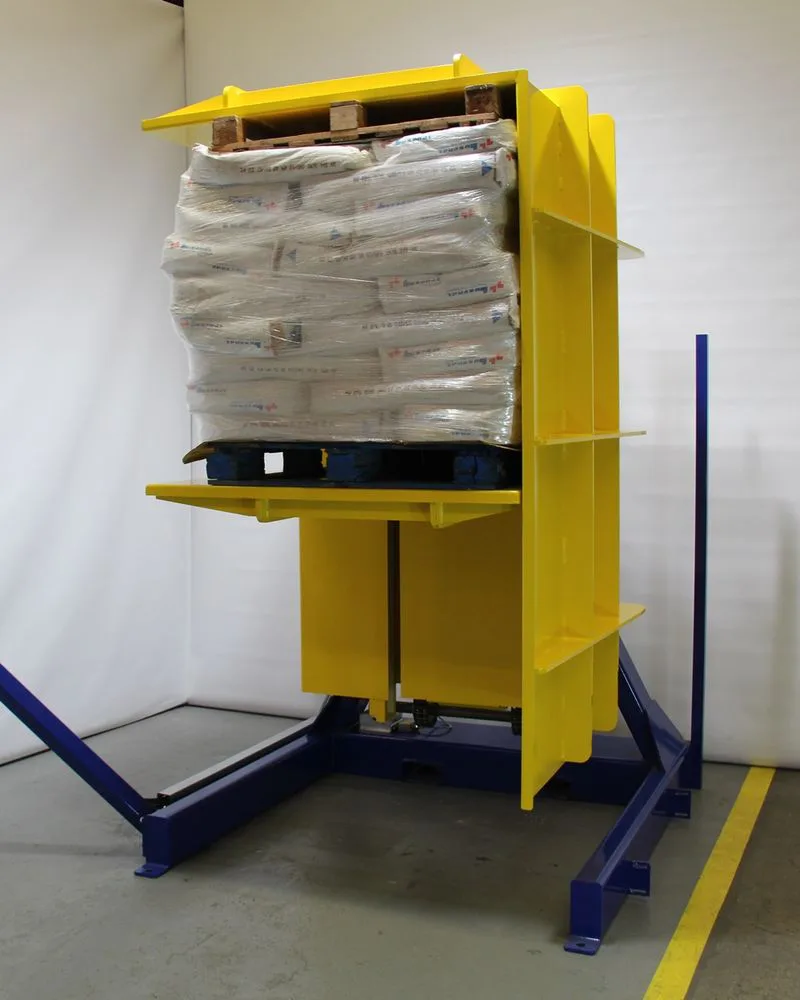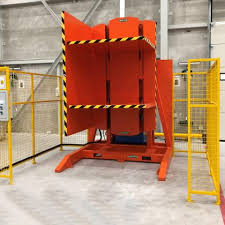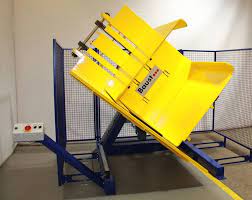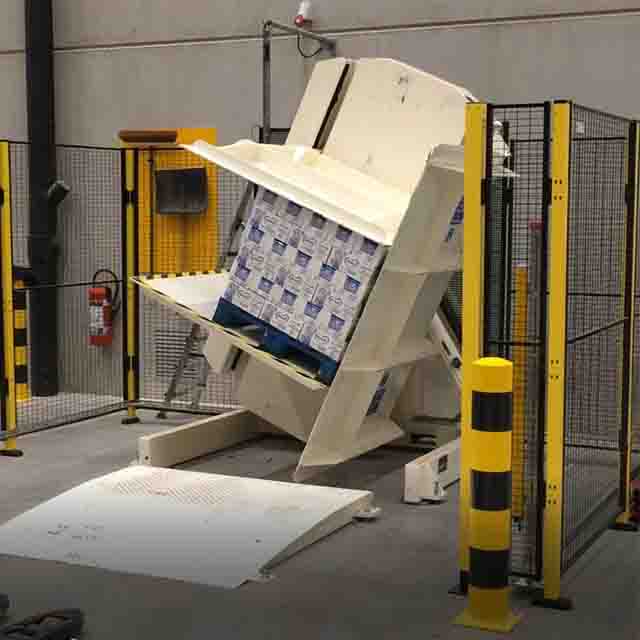Pallet Inverter: How Can Chem Plants Reduce Spill Risk When Changing Pallets?
Handling drums of chemicals or bags of sensitive powders presents a constant challenge. You need to switch a load from one pallet to another, maybe from a house pallet to a shipping pallet, or to replace a damaged one. The traditional way, by hand or with a clumsy forklift maneuver, is an open invitation for disaster. A single slip can lead to a dangerous spill, halting production, costing a fortune in cleanup and fines, and putting your team's safety at risk. This constant worry is a heavy burden for any plant manager.
A pallet inverter is the most effective way for chemical plants to reduce spill risk during pallet changes. It works by securely clamping the entire load, including the pallet, and then rotating it 180 degrees. This allows the old pallet to be removed from the top and the new pallet to be placed on the load before it is rotated back. The process is fully contained and automated, eliminating manual handling and keeping the product stable and secure from start to finish.

I've spent my entire career in the packaging machinery world, from my first days on the factory floor to building my own company, SHJLPACK. I've seen firsthand how a simple operational challenge can become a major bottleneck or a serious safety hazard. The issue of changing pallets in a chemical environment is a perfect example. So, now that we understand what a pallet inverter does, let's break down exactly how it transforms this risky task into a safe, efficient part of your workflow. We will look at the direct safety improvements, the impact on your operational costs, and how to choose the right machine for your specific needs.
What Are the Direct Safety Benefits of Using a Pallet Inverter in a Chemical Plant?
Your team is working with hazardous or high-value materials. Every time a pallet needs to be changed manually, you hold your breath. Workers are lifting, pushing, and pulling heavy, unstable loads. The risk of a back injury is high. The risk of a forklift tine puncturing a drum or bag is even higher. A spill doesn't just mean lost product; it means potential exposure, environmental contamination, and regulatory nightmares.
The primary safety benefit of a pallet inverter is the near elimination of these risks. By mechanizing the pallet exchange process, it removes the human element from the most dangerous parts of the task. The machine clamps, lifts, and rotates the load in a controlled, predictable motion, drastically reducing the chances of accidents and injuries.

Let’s dive deeper into how this single piece of equipment creates a safer work environment. It's not just about preventing one type of accident. It's about a systematic reduction of multiple risk factors that are common in chemical handling facilities.
Mitigating Musculoskeletal Disorders (MSDs)
Manual pallet changing is physically demanding. Team members often have to restack heavy bags, boxes, or drums from one pallet to another. This involves repetitive bending, lifting, and twisting, which are classic causes of MSDs. These injuries are not only painful for the employee but also costly for the company in terms of lost workdays, compensation claims, and reduced morale. A pallet inverter takes the load. The operator simply uses a forklift to place the entire palletized load into the machine and then retrieves it a minute later. There is no manual lifting of the product itself. This directly protects your workers' long-term health.
Preventing Catastrophic Spills and Exposure
The most immediate danger in a chemical plant is a spill. Using the "forklift and push" method or manually restacking creates numerous opportunities for failure. A load can shift, a bag can tear, or a drum can tip over. When dealing with corrosive, flammable, or toxic substances, the consequences are severe. A pallet inverter's design is focused on load integrity.
| Risk Factor in Manual Methods | How a Pallet Inverter Solves It |
|---|---|
| Load Instability | The machine's clamping walls apply even pressure to all sides of the load, securing it before any movement begins. |
| Punctures from Forklifts | The load is placed in the machine, so there is no direct, forceful interaction between forklift tines and the product containers. |
| Human Error | The process is automated and controlled by the machine, removing variables like operator fatigue or misjudgment during the transfer. |
| Sudden Shifts | The rotation is smooth and controlled, unlike the jarring movements of manual or push-off methods. |
By containing the product securely, the inverter not only prevents spills but also minimizes employee exposure to harmful chemicals through fumes or direct contact. This is critical for meeting health and safety regulations and creating a workplace where people feel safe.
How Does a Pallet Inverter Improve Operational Efficiency and Reduce Costs?
You're constantly looking at the numbers. Labor costs, cycle times, product damage, and equipment uptime are always on your mind. The traditional way of changing pallets is a huge drain on resources. It can take two or more employees a significant amount of time to manually restack a load. During that time, they aren't performing other value-added tasks, and your production line might even be waiting. Any product damaged in the process is a direct loss to your bottom line.
A pallet inverter transforms this slow, costly process into a fast, efficient one. It drastically cuts down the time and labor required for a pallet exchange. This immediately frees up your staff and gets your products moving faster. The reduction in product damage adds directly to your profitability.

Let's look closely at the numbers and the process. The impact on your operational efficiency is not just a small improvement; it's a fundamental change in how you handle materials. This change ripples through your entire logistics chain, from the production floor to the shipping dock.
A Head-to-Head Comparison: Manual vs. Inverter
To truly understand the impact, let's compare the two methods side-by-side. Imagine you need to switch a pallet of 50 bags of chemical powder, each weighing 25 kg.
| Metric | Manual Restacking Method | Pallet Inverter Method |
|---|---|---|
| Time per Pallet | 15-20 minutes | 1-2 minutes |
| Labor Required | 2 employees | 1 forklift operator |
| Risk of Product Damage | High (dropped bags, tears) | Very Low (contained process) |
| Risk of Worker Injury | High (lifting, bending) | Very Low (no manual lifting) |
| Throughput (Pallets/Hour) | 3-4 | 30-40 |
The difference is stark. You are looking at a potential 10x increase in throughput with half the labor. This is not a marginal gain. For a business owner like Javier, who aims to increase capacity utilization to 95%, eliminating these kinds of bottlenecks is essential. The time saved can be reallocated to other critical tasks, increasing the overall productivity of your workforce.
Quantifying the Cost Savings
The efficiency gains translate directly into tangible cost savings. Let's break it down:
- Reduced Labor Costs: If a pallet exchange takes 15 minutes for two workers, that's 30 man-minutes per pallet. An inverter does it in 2 minutes with one operator. That's a 93% reduction in labor time per pallet. Over hundreds or thousands of pallets a year, this saving is substantial.
- Elimination of Product Damage: Let's say your manual process has a 1% damage rate. If the product on a pallet is worth $2,000, you are losing $20 on average every time you switch a pallet. If you do this 20 times a day, that's $400 lost daily, or over $100,000 a year. A pallet inverter's secure process can bring this damage rate to near zero.
- Increased Throughput: Faster pallet changing means faster loading and unloading of trucks. This reduces driver waiting times, avoids potential demurrage fees, and improves your relationship with logistics partners. It also means your internal processes, like moving goods from production to the warehouse, are smoother and more efficient.
These savings go directly toward the goal of reducing overall operating costs, a key objective for any forward-thinking plant owner.
What Types of Pallet Inverters Are Best Suited for Chemical Applications?
You know you need a solution, but the world of industrial machinery can be confusing. Not all pallet inverters are the same. Choosing the wrong one could mean it doesn't fit your workflow, can't handle your specific product, or doesn't provide the level of safety you need. For chemical applications, the stakes are higher. You need to consider the nature of your product—is it a liquid in drums, a powder in sacks, or solid boxes?
The best pallet inverter for a chemical plant is one that matches the product's characteristics and the facility's workflow. The most common and versatile choice is a 180-degree free-standing inverter, but other models like 90-degree tippers or inline systems might be better for specific, high-volume applications.

Making the right choice is about understanding the technology and how it aligns with your specific needs. As an engineer, this is where I get passionate. Let's break down the main types and what you should look for when selecting a machine for handling chemicals.
Choosing the Right Machine for the Job
The decision depends on a few key factors: the state of your product (solid, liquid, powder), the container type (bags, drums, boxes, pails), and your required throughput.
1. The 180-Degree Free-Standing Inverter
This is the workhorse of pallet inverters and the most common choice for chemical plants due to its versatility.
- How it Works: A forklift places the load into the machine. Two clamping tables secure the load from the top and bottom. The entire load is then rotated a full 180 degrees. The operator can then raise the platform, and the old pallet rests on top, ready to be removed. A new pallet is placed, and the load is rotated back.
- Best for: A wide variety of products. It's excellent for sacks of powder, boxes, and even pails because the clamping pressure keeps everything stable. It is the most secure method for loads that could easily shift.
- Considerations: Look for models with adjustable clamping pressure. This is crucial for chemical plants. You need enough pressure to secure a heavy load of dense powder, but you don't want to crush more delicate containers.
2. The 90-Degree Tipper (Load Tilter)
This machine works a bit differently and is often used for specific types of loads.
- How it Works: The load is placed on a platform. The machine tilts the load back 90 degrees until it rests on its side against a back wall. The pallet is now vertical and can be easily removed. A new pallet is placed, and the load is tilted back down.
- Best for: Stable, solid loads like blocks, rigid boxes, or well-secured drums. It is generally not recommended for bags of powder or unstable loads, as gravity can cause the product to shift during the tilt.
- Considerations: It can be faster than a 180-degree inverter and is often less expensive. However, its application in a diverse chemical plant is limited. It's a specialist tool, not a generalist one.
Here is a simple table to guide your decision:
| Inverter Type | Best for... | Not Ideal for... | Key Feature |
|---|---|---|---|
| 180-Degree Inverter | Bags, Sacks, Boxes, Pails, Mixed Loads | Loads sensitive to top pressure (requires adjustment) | Maximum load security through full rotation and clamping. |
| 90-Degree Tipper | Solid Boxes, Rolls, Secured Drums | Loose bags of powder, unstable or delicate loads | Speed and simplicity for stable, block-like loads. |
For most chemical plant managers I've worked with, the 180-degree inverter offers the best balance of safety, flexibility, and security.
My Insight
Over the years, I’ve met many factory owners like Javier. They are sharp, they know their business, and they don't invest in equipment just because it's new. They invest in solutions that solve real problems and deliver a clear return. I remember one client, a manager at a specialty chemical company. His facility was modern in many ways, but they were still changing pallets of high-value pigments by hand.
He told me, "Vincent, my biggest fear isn't a forklift crash. It's a small mistake. A single torn bag of this pigment can contaminate an entire batch of another product. The cleanup is a nightmare, but the cross-contamination can cost us hundreds of thousands."
He was looking at pallet inverters, but he was skeptical. He saw a machine, a cost on a spreadsheet. My job wasn't to sell him a machine. My job, as I see it with SHJLPACK, is to provide a total solution. We didn't just talk about the inverter's specs. We walked his factory floor. We watched his team work. We timed the process. We calculated the real cost of their current method—the labor, the time, the small but steady loss from damaged bags, and the huge potential cost of a contamination event.
We selected a 180-degree inverter with adjustable hydraulic pressure and stainless steel cladding to make clean-down easy. But we didn't stop there. We helped him redesign the workflow around the machine. We created a dedicated pallet-changing station, ensuring a smooth flow of materials from the production line to the inverter and then to the warehouse.
A few months later, he called me. "The machine paid for itself faster than we calculated," he said. "But that's not the main thing. My team feels safer. There's no more stress about dropping a bag. The 'what if' is gone."
That's what this is about. It's not just about steel and hydraulics. It’s about understanding the deep challenges of a business—safety, efficiency, peace of mind—and delivering a comprehensive solution. My journey from an engineer to a factory owner taught me that gratitude and success come from helping others succeed. Sharing this knowledge, and helping people find not just a machine but the right solution, is how I give back.

Conclusion
Ultimately, a pallet inverter is a critical investment for chemical plants to enhance safety, boost efficiency, and protect profits by turning a risky manual task into a controlled, automated process.




